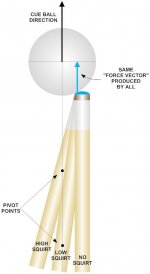Parallel English is a technique of moving the cue stick parallel to the aim line (aimed at the new offset point), to introduce sidespin. This I know.
Different cues will have different squirt.
My question is, is the squirt the same if you hit half a tip off-centre and two tip off-centre. I presume they will be different. If so, which has more squirt?
I am not familiar with parallel English. Many swear by it whilst others rubbished it.
Different cues will have different squirt.
My question is, is the squirt the same if you hit half a tip off-centre and two tip off-centre. I presume they will be different. If so, which has more squirt?
I am not familiar with parallel English. Many swear by it whilst others rubbished it.
